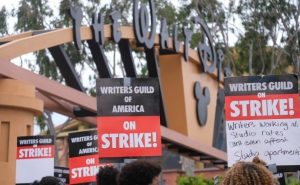 Mysteries
Mysteries  Mysteries
Mysteries  Music
Music 10 Musicians Who Changed How Everyone Plays Their Instruments
 Humans
Humans 10 Inventors Who Died Awful Deaths in Their Own Creations
 Animals
Animals 10 Ways Animals Use Deception to Survive
 Movies and TV
Movies and TV 10 Misdirections Directors Used to Manipulate Actors
 Politics
Politics The 10 Boldest Coup Attempts of the 21st Century
 Weird Stuff
Weird Stuff 10 Things That Would Have Killed You in the Old West
 Books
Books 10 Pen Names More Famous Than Their Authors
 Creepy
Creepy 10 Unnerving Legends from Around the World
 Movies and TV
Movies and TV 10 Amazing Lead Actor Ideas for Superhero Movies
 Mysteries
Mysteries 10 Bizarre, Little-Known Phenomena
 Music
Music 10 Musicians Who Changed How Everyone Plays Their Instruments
 Humans
Humans 10 Inventors Who Died Awful Deaths in Their Own Creations
Who's Behind Listverse?

Jamie Frater
Head Editor
Jamie founded Listverse due to an insatiable desire to share fascinating, obscure, and bizarre facts. He has been a guest speaker on numerous national radio and television stations and is a five time published author.
More About Us Animals
Animals 10 Ways Animals Use Deception to Survive
 Movies and TV
Movies and TV 10 Misdirections Directors Used to Manipulate Actors
 Politics
Politics The 10 Boldest Coup Attempts of the 21st Century
 Weird Stuff
Weird Stuff 10 Things That Would Have Killed You in the Old West
 Books
Books 10 Pen Names More Famous Than Their Authors
 Creepy
Creepy 10 Unnerving Legends from Around the World
 Movies and TV
Movies and TV 10 Amazing Lead Actor Ideas for Superhero Movies
10 Things You Never Knew About Hollywood’s Blacklist Era
In the wake of World War II, the looming threat of a nuclear conflict with the Soviet Union instilled a pervasive sense of apprehension across the United States. Soon, it led various institutions to fortify their commitment to what they saw as critical American values.
In Hollywood, this phenomenon really took hold in 1944 with the emergence of the Motion Picture Alliance for the Preservation of American Ideals. The organization soon became known as the MPA. It made sure any entertainer involved in screenwriting, directing, or acting faced immediate ostracization from the industry if they were suspected of communist ties.
The birth of the MPA was motivated by a desire to safeguard American values. It sought to act as a guardian against potential subversive influences within entertainment. Its actions were driven by the perceived necessity to preserve American cinema amid an ideological struggle with the Soviet Union.
While we look down on the MPA’s actions today, it was very powerful at the time. The power its members wielded was used to crush many careers of “subversive””” entertainers. These writers, directors, filmmakers, and actors were blacklisted from working in Hollywood. Many waited years to work again—if at all. In this list, you’ll learn all about ten shocking and lesser-known stories from that unfortunate era of American cinema.
Related: 10 Golden Hollywood Scandals That Were Covered Up
10 Depression-Era Wage Wars Set the Stage

Amid the Great Depression, a wave of concern swept across the nation. Countless Americans feared the loss of their livelihoods. Wage workers, in particular, faced the harsh reality of being underpaid for their efforts. Fueled by this injustice, laborers nationwide decided to take collective action by forming unions.
Among these was the American Federation of Actors, which was first established in 1933. It was later expanded to encompass technicians in the film industry through the Screen Guild. Thus, it became what we know today as the Screen Actors Guild. Some of these organizations were indeed founded by members affiliated with the American Communist Party. But they weren’t Soviet sympathizers as much as they simply wanted fair wages and improved working conditions.
While picketing for their own labor rights in the late 1930s, screenwriters and directors demonstrated solidarity with other industry professionals like cameramen, set builders, and technical workers. Unfortunately, their association with the communist ideology led many to be targeted and later blacklisted.
Of course, present-day labor movements in Hollywood—like the Screen Actors Guild and the Writer’s Guild—owe much of their successes to these early efforts. But this pioneering fight for fair pay in the film industry set the stage for a very difficult era ahead. Studios would fight back with blacklists and outright bans, and for a while, screenwriters and filmmakers were mostly powerless to stop them.[1]
9 The Tale of the Hollywood Ten
The Hollywood Ten were a bunch of screenwriters who faced accusations of sympathizing with the Communist Party. In November 1947, they were summoned before the House Un-American Activities Committee in Congress and had to answer some tough questions.
Immediately, it was like being caught between a rock and a hard place. If they denied being Communists, they would face even more probing questions. On the other hand, if they admitted their association with the party, they were relentlessly pressed to reveal the names of other party members they knew. The House Un-American Activities Committee insisted that all suspected Communists admit their involvement. For the writers, the only way they could escape the ordeal was by betraying their friends and exposing other party members.
However, the group of ten, including famed writer Dalton Trumbo, chose not to respond to these questions. That was their right protected by the Fifth Amendment, but it didn’t offer them an easy future. Of course, we now know these men hadn’t committed any crimes. They had the freedom to express their thoughts according to the First Amendment.
However, they were all sent to prison for contempt of court and barred from working in Hollywood ever again. Years later, many of these writers—including Trumbo—managed to continue their writing careers. They penned scripts under fake names and worked by secretly ghostwriting for their friends.[2]
8 Beware of Hedda Hopper
Hedda Hopper was a former actress who took on a new role later in life as a gossip columnist. She wrote “Hedda Hopper’s Hollywood” for the Los Angeles Times through the middle of the 20th century. She had strong conservative views and no qualms about writing negatively about those she disliked. She especially detested those actors and filmmakers suspected of being communists. Her influence extended beyond print to radio and TV, where she used her position to instill fear in people. Her popularity in the paper effectively forced them to conform or risk having their reputations destroyed.
Although Hopper claimed her crusade against the “Red Menace” was driven by her loyalty to America, she single-handedly ruined the reputations of countless stars. It didn’t matter much if someone was labeled a “Communist,” gay, or simply deemed “immoral” by Hopper. All their personal lives and lifestyles were fair game for her.
Shockingly, some of the people she targeted were so devastated by her relentless humiliation that they tragically took their own lives. Once, British actress Merle Oberon confronted Hopper and asked her why she derived so much pleasure from ruining lives. “Bitchery, dear,” Hopper cruelly responded. “Sheer bitchery.”
Hedda’s larger-than-life persona has been depicted in a few films, such as 1999’s RKO 291 and 2015’s Trumbo. Additionally, her character served as inspiration for Tilda Swinton’s portrayal in 2016’s Hail Caesar! The 2017 FX series Feud: Bette and Joan also captured a scene where Hopper threatened to destroy her friend’s reputation by exposing old nude photos from her youth, then reveling in the destruction it caused.[3]
7 Don’t Diss the Company… Ever!
In a movie called The President’s Mystery, released back in 1936, a story unfolded about a wealthy factory owner who made a tough decision. He decided to close down the factory—not because the company had gone bankrupt, but simply to save money by cutting jobs deemed unnecessary. Unfortunately, this meant many hardworking people lost their livelihoods and got laid off.
The film was written by Lester Cole, who adapted it from a novel originally penned by Sinclair Lewis. Interestingly, Cole would later become one of the aforementioned Hollywood Ten. And The President’s Mystery was no small reason why. Business moguls and American leaders were concerned movies like Cole’s 1936 flick depicted business owners and corporations in too negative of a light.
In reality, we all know companies sometimes resort to laying off employees as a way to cut costs. But during the 1940s and 1950s, if a screenwriter dared to depict corporations as “the bad guys” or ever showed unhappy workers, it was deemed un-American. That, in turn, was punishable by being blacklisted.
This mindset prevailed during those two decades and greatly shaped public perception. It became ingrained in the concept of “The American Dream.” With that ideal, finding a job, being loyal, and working until retirement were the ideal paths to success. By those standards, a more recent movie like Office Space might have been seen as the most “communist” film ever made.
As time went on, especially in the 1980s, laying off employees for budgetary reasons became common. By the early 2000s, it seemed like everyone knew someone who had gone through this rough experience. Then, when the Great Recession struck in 2008, the truth about corporate corruption became really undeniable.
Instead of suppressing this truth, Hollywood started releasing movies like The Big Short, which exposed the rampant greed within corporate America. These films aimed to shed light on the harsh realities of our financial systems and the consequences they have on everyday people. But way back when, that wasn’t possible. Old films could only show happy workers—or risk being banned![4]
6 The Fight against Feminism
There was a time when filmmakers with supposed communist sympathies included strong female characters in their movies. In the Soviet Union, for example, many mid-century films showcased courageous women. They were often portrayed by the talented Tatyana Samoylova, best known for her unforgettable performance in The Cranes Are Flying.
In the 1940s, Hollywood also produced some notable feminist movies. However, they started to fade fast after World War II. When husbands returned from war, they found it challenging to convince their wives to give up their jobs. Politicians in America wanted them back as full-time housewives. This shift toward work posed a threat to the traditional American way of life, many leaders believed. It didn’t help that the Soviet films, which depicted women successfully balancing work and raising children, were treated as communist propaganda.
In 1951, a film titled I Can Get It for You Wholesale premiered. It centered around Harriet, a woman who declined a marriage proposal to pursue a career as a fashion designer in New York City. Ultimately, Harriet realized that friends, family, and love held greater value than money. Although the movie conveyed pro-capitalism messages and celebrated the entrepreneurial spirit, its focus on a successful woman and its moral lesson were deemed “un-American.” Consequently, the film was banned to prevent the alleged “brainwashing” of the masses.
Abraham Polonsky, the writer and director of I Can Get It for You Wholesale, faced interrogation for the film. He was eventually blacklisted from the film industry. Consequently, writers became apprehensive about incorporating feminist themes into their scripts. They feared accusations of communist sympathy from higher-ups.
It took decades for Hollywood to recover from the impact of the blacklist on feminism. But throughout the 1950s, the image of the ideal stay-at-home mom who had the kids in check and dinner ready by 5:00 pm dominated nearly every film.[5]
5 Disney Backed the MPA… Sort Of
During World War II, Walt Disney created several films for the U.S. Government. These movies aimed to promote specific ideas. For one, they clearly showed his opposition to the oppressive ways of Nazi fascism. This led to his appointment as Vice President of the Motion Picture Alliance. As we’ve seen already, the MPA’s main goal was to uncover hidden fascists and communists in the movie industry. For Disney and others in the organization, they believed the World War II battle against Nazism was not yet won.
As the biggest provider of wholesome American entertainment, Disney wanted to assist the organization in identifying negative content in Hollywood. However, he did not publicly participate in the persecution of communists. MPA President Sam Wood was very open about going after screenwriters and filmmakers, but Disney hung back a bit. There is little information available about Disney’s involvement in the MPA. What we do know is that he frequently clashed with Wood regarding the organization’s operations.
Shortly after the war, Walt Disney was removed from his position as MPA Vice President. And yet he still retained some anti-communist leanings. In the late 1940s, when artists at one of his studios went on strike, Disney accused communists of orchestrating it.
Nevertheless, he did not attempt to expose or dismiss individuals he suspected of being communists. His belief was that some communist ideas were influencing the younger generation and causing change. However, he never publicly targeted specific individuals—and as the blacklist era ramped up through the 1950s, he mostly hung out on the sidelines.[6]
4 John Wayne Took a Hardline Stance
John Wayne is world-famous for his roles in numerous western movies. Even today, he holds a prominent place in Hollywood history. However, there was one particular film, High Noon, which sparked a major disagreement for him. In that 1952 movie, the script calls for a corrupt sheriff to face disrespect from the townspeople.
However, that theme deeply troubled Wayne. He strongly believed such behavior was un-American and saw it as a form of pro-communist propaganda. Wayne never changed, going all the way to his death in 1979 believing that. Years later, in interviews later in life, the Duke slammed un-American filmmaking of the tumultuous period and railed against communism and “radical liberals.”
As it turned out, screenwriter Carl Foreman carefully crafted the film as an allegory to shed light on the McCarthy-era witch hunts. Although Foreman won an Oscar for his exceptional work, his involvement in the Communist Party during his youth led to long-term trouble. He confessed to his past associations when questioned by the House Un-American Activities Committee.
Even though he had long severed ties with the party, his motives were considered suspect. And yet, when pressured to reveal the names of other communists, Foreman refused. This decision resulted in him being blacklisted from the film industry along with the Hollywood Ten. Consequently, Foreman had to work as a ghostwriter. For years, he allowed others to claim credit for his exceptional screen work.[7]
3 Ronald Reagan Turns Tail
Before Ronald Reagan became president of the United States, he had an important role in the Screen Actors Guild. It all started back in 1946 when he found himself in the middle of a disagreement between two Hollywood unions. One of the groups, led by a member of the Communist Party, was causing a public commotion in seeking enhanced worker protections. That incident made Reagan think communists were out to take over Hollywood and undermine the American way of life.
The following year, in 1947, Reagan reportedly began working with the FBI as an informant. His task was to provide the names of known communists in the film industry. Unfortunately, his dedication to this cause had consequences for his personal life. His first wife, Jane Wyman, requested a divorce from him because of the backdoor move.
Interestingly, even though Reagan was actively fighting against communism, he decided to remove Nancy Davis’s name from the list. Instead of seeing her as a threat, he fell in love with her. She suddenly wasn’t a communist anymore, they got married, and she, of course, became the soon-to-be infamous Nancy Reagan.
In time, these controversial experiences ignited Reagan’s interest in politics. It eventually led him to pursue a career in public service. He went on to become the governor of California and later president of the United States.[8]
2 Furious Filmmakers Fight Back
Months and years after the Hollywood Ten faced persecution, Hollywood stars finally began standing up for their rights. Many renowned actors and actresses, like Lucille Ball, Lauren Bacall, Judy Garland, and Humphrey Bogart, joined forces as part of the Committee for the First Amendment. The majority of these celebrities held liberal views. While they themselves were not communists, they witnessed the corruption and complete disregard for the Constitutional rights of the Hollywood Ten. Regrettably, those who attempted to advocate for the rights of Hollywood communists soon found themselves targets.
In 1948, Humphrey Bogart penned an article titled “I’m No Communist.” He intended to clarify his involvement in the Committee for the First Amendment. However, his association with the committee caused friends to turn against him. They mistakenly labeled him as a communist.
Bogart received menacing letters in the mail and faced harassment in public. He infamously compared the barrage of accusations to being asked, “When did you stop beating your wife?” The only options to answer that question were “yes,” or “no,” and each implied guilt. In such a scenario, one is doomed regardless of their response. The relentless pressure compelled many of these actors to yield under its weight.
Thankfully, though, the Committee for the First Amendment persisted. More Hollywood stars soon began to see the group’s wise ways regarding free speech. Plus, they came to be incensed at Bogart’s treatment through it all. Things didn’t change right away for those blacklisted, but it was in the air. Soon enough, one of Hollywood’s most shameful eras would come to a sputtering close.[9]
1 Blacklist Fever Finally Breaks
Ghostwriting became a lifeline for blacklisted screenwriters who wanted to keep working. One of the most talented writers was Dalton Trumbo. He secretly penned the hugely popular film Roman Holiday and passed it off to pal Ian McClellan Hunter. The movie went on to win an Academy Award, but Trumbo remained uncredited for his work. It took several decades before justice prevailed.
King Brothers Productions, sympathetic to Trumbo’s plight, offered him meager wages to write B-movies. It was a far cry from the high pay he once received for screenplays. But Trumbo’s talents shone through. In 1957, he triumphed with The Brave One, which won him another Academy Award. To protect his identity, he used the pseudonym “Robert Rich.”
The turning point arrived in 1960 when Kirk Douglas starred in the epic film Spartacus. With his influential position, Douglas insisted on Trumbo receiving proper credit for the screenplay. Finally, Trumbo’s real name graced the screen again. His life journey was so remarkable that a film called Trumbo was released in 2015. It featured acclaimed actor Bryan Cranston as the titular character. Its popularity showed the dark side of old Hollywood to a new generation of moviegoers.
As for the MPA, the HUAC, and the Hollywood blacklist, it all lingered on a little while longer. Despite the symbolic victory of Spartacus, the official end of the Blacklist era wasn’t quite ready yet. For more than a decade longer, the House Un-American Activities Committee continued its existence. Then, in 1975, it was disbanded after slowly fading from relevancy—finally bringing down the curtain on the era’s dark shame.[10]








